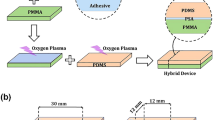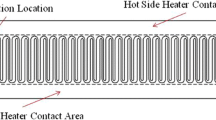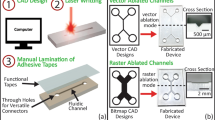Abstract
Laser patterned adhesive transfer tapes are a rapid, versatile, and low cost option to fabricate microfluidic platforms. In this work, we examined the compatibility with polymerase chain reaction (PCR) of different types of adhesive tape materials patterned with a CO2 laser cutter. Acrylic, polyimide, and silicone-based tapes were considered. We performed a systematic study on off-the-shelf adhesive tapes with respect to fluid handling, PCR inhibition, reagent loss, and on-chip PCR reaction. A novel microfluidic PCR approach was implemented that combines the advantages of previously reported systems. It uses a thermal gradient from a single heating element and the thermocycling was carried out by passing the reaction mixture back and forth in a microfluidic channel strategically placed along the thermal gradient. Only the silicone-based tapes were compatible with on-chip PCR. The overall fabrication process takes less than 30 min, uses only off-the-shelf finished or semi-finished materials, and is amenable to large-scale reel-to-reel processing.




Similar content being viewed by others
References
Becker H (2010) Mind the gap! Lab Chip 10(3):271–273
Blow N (2009) Microfluidics: the great divide. Nat Meth 6(9):683–686
Crews N, Wittwer C, Gale B (2008) Continuous-flow thermal gradient PCR. Biomed Microdevices 10(2):187–195. doi:10.1007/s10544-007-9124-9
Focke M, Kosse D, Muller C, Reinecke H, Zengerle R, von Stetten F (2010) Lab-on-a-foil: microfluidics on thin and flexible films. Lab Chip 10(11):1365–1386
Khan Malek C, Robert L, Salut R (2009) Femtosecond laser machining and lamination for large-area flexible organic microfluidic chips. Eur Phys J Appl Phys 46(01):null–null. doi:10.1051/epjap/2009027
Kim J, Xu X (2003) Excimer laser fabrication of polymer microfluidic devices. J Laser Appl 15(4):255
Kim TN, Campbell K, Groisman A, Kleinfeld D, Schaffer CB (2005) Femtosecond laser-drilled capillary integrated into a microfluidic device. Appl Phys Lett 86(20):201106
Li H, Fan Y, Kodzius R, Foulds I (2012) Fabrication of polystyrene microfluidic devices using a pulsed CO2 laser system. Microsyst Technol 18(3):373–379. doi:10.1007/s00542-011-1410-z
Lutz S, Weber P, Focke M, Faltin B, Hoffmann J, Muller C, Mark D, Roth G, Munday P, Armes N, Piepenburg O, Zengerle R, von Stetten F (2010) Microfluidic lab-on-a-foil for nucleic acid analysis based on isothermal recombinase polymerase amplification (RPA). Lab Chip 10(7):887–893
Mukhopadhyay R (2007) When PDMS isn’t the best. Anal Chem 79(9):3248–3253. doi:10.1021/ac071903e
Nath P, Fung D, Kunde YA, Zeytun A, Branch B, Goddard G (2010) Rapid prototyping of robust and versatile microfluidic components using adhesive transfer tapes. Lab Chip 10(17):2286–2291
Pješčić I, Tranter C, Hindmarsh P, Crews N (2010) Glass-composite prototyping for flow PCR with in situ DNA analysis. Biomed Microdevices 12(2):333–343. doi:10.1007/s10544-009-9389-2
Schaff UY, Sommer GJ (2011) Whole blood immunoassay based on centrifugal bead sedimentation. Clin Chem 57(5):753–761. doi:10.1373/clinchem.2011.162206
Shen K, Chen X, Guo M, Cheng J (2005) A microchip-based PCR device using flexible printed circuit technology. Sens Actuators B Chem 105(2):251–258. doi:10.1016/j.snb.2004.05.069
Siegrist J, Gorkin R, Bastien M, Stewart G, Peytavi R, Kido H, Bergeron M, Madou M (2010) Validation of a centrifugal microfluidic sample lysis and homogenization platform for nucleic acid extraction with clinical samples. Lab Chip 10(3):363–371
Trung NB, Saito M, Takabayashi H, Viet PH, Tamiya E, Takamura Y (2010) Multi-chamber PCR chip with simple liquid introduction utilizing the gas permeability of polydimethylsiloxane. Sens Actuators B Chem 149(1):284–290. doi:10.1016/j.snb.2010.06.013
Velten T, Schuck H, Richter M, Klink G, Bock K, Malek CK, Roth S, Schoo H, Bolt PJ (2008) Microfluidics on foil: state of the art and new developments. Proc Inst Mech Eng Part B J Eng Manuf 222(1):107–116. doi:10.1243/09544054jem866
Velten T, Schuck H, Haberer W, Bauerfeld F (2010) Investigations on reel-to-reel hot embossing. Int J Adv Manuf Technol 47(1):73–80. doi:10.1007/s00170-009-1975-1
Wang F, Burns M (2009) Performance of nanoliter-sized droplet-based microfluidic PCR. Biomed Microdevices 11(5):1071–1080. doi:10.1007/s10544-009-9324-6
Whitesides GM, Ostuni E, Takayama S, Jiang X, Ingber DE (2001) Soft lithography in biology and biochemistry. Annu Rev Biomed Eng 3(1):335–373. doi:10.1146/annurev.bioeng.3.1.335
Xia Y, Whitesides GM (1998) Soft lithography. Annu Rev Mater Sci 28(1):153–184. doi:10.1146/annurev.matsci.28.1.153
Zhang C, Xing D (2007) Miniaturized PCR chips for nucleic acid amplification and analysis: latest advances and future trends. Nucleic Acids Res 35(13):4223–4237. doi:10.1093/nar/gkm389
Acknowledgments
This work was funded by a Department of Energy Laboratory Directed Research and Development Grant (20070010-DR) at Los Alamos National Laboratory. The authors thank Michelle Espy, Momchilo Vuyisich, Scott White, Andrew Badbury, Ahmet Zeytun, Alina Deshpande, and John Dunbar for valuable discussions.
Author information
Authors and Affiliations
Corresponding author
Rights and permissions
About this article
Cite this article
Nath, P., Maity, T.S., Pettersson, F. et al. Polymerase chain reaction compatibility of adhesive transfer tape based microfluidic platforms. Microsyst Technol 20, 1187–1193 (2014). https://doi.org/10.1007/s00542-013-1901-1
Received:
Accepted:
Published:
Issue Date:
DOI: https://doi.org/10.1007/s00542-013-1901-1




